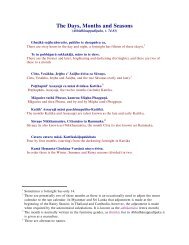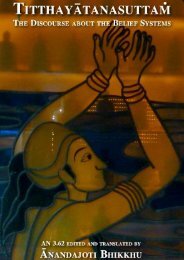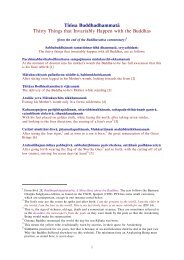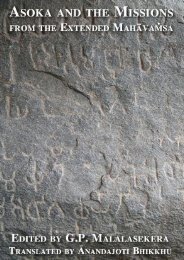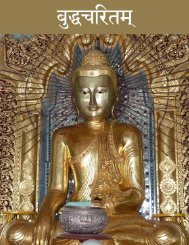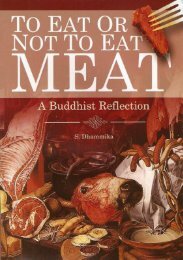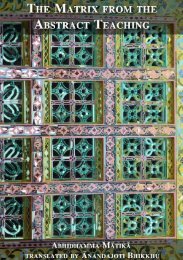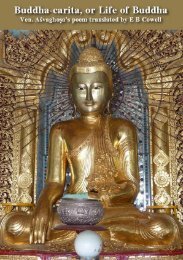Mahaparinibbanasuttam (DN 16) - Ancient Buddhist Texts
Mahaparinibbanasuttam (DN 16) - Ancient Buddhist Texts
Mahaparinibbanasuttam (DN 16) - Ancient Buddhist Texts
You also want an ePaper? Increase the reach of your titles
YUMPU automatically turns print PDFs into web optimized ePapers that Google loves.
The Fourth Chapter for Recitation - 147<br />
Sutte osāretabbāni 177 Vinaye sandassetabbāni.<br />
they should be laid alongside the Discourses, they should be compared with the<br />
Discipline. 178<br />
Tāni ce Sutte osāriyamānāni Vinaye sandassiyamānāni,<br />
If, when these are laid alongside the Discourses, compared with the Discipline,<br />
na ceva Sutte osaranti na ca Vinaye sandissanti,<br />
they do not fit in with the Discourses, they do not compare (well) with the Discipline,<br />
niṭṭham-ettha gantabbaṁ: ‘Addhā idaṁ na ceva tassa Bhagavato vacanaṁ,<br />
you may here come to this conclusion: ‘Certainly this is not the Gracious One’s word,<br />
imassa ca bhikkhuno duggahitan’-ti iti hetaṁ bhikkhave chaḍḍeyyātha.<br />
it is not well learned by that monk,’ and, monks, you should abandon it.<br />
Tāni ce Sutte osāriyamānāni Vinaye sandassiyamānāni,<br />
If when these are laid alongside the Discourses, compared with the Discipline,<br />
Sutte ceva osaranti Vinaye ca sandissanti,<br />
they do fit in with the Discourses, they do compare (well) with the Discipline,<br />
niṭṭham-ettha gantabbaṁ: ‘Addhā idaṁ tassa Bhagavato vacanaṁ,<br />
you may come to this conclusion: ‘Certainly this is the Gracious One’s word,<br />
imassa ca bhikkhuno suggahitan’-ti<br />
it is well-learned by that monk.’<br />
Idaṁ bhikkhave paṭhamaṁ Mahāpadesaṁ dhāreyyātha.<br />
This, monks, is the first Great Referral you should bear in mind.<br />
* * *<br />
177 BJT, PTS: otāretabbāni, and similarly throughout. The (ChS) Commentary gives these laconic<br />
definitions: “Sutte osāretabbānī” ti sutte otāretabbāni. “Vinaye sandassetabbānī” ti vinaye<br />
saṁsandetabbāni. This reading rules out taking otāretabbāni in the text. Without taking this<br />
interpretation into account the natural meaning would be admitted into the Discourses, instructed<br />
in the Discipline. As it is hard to make sense of this in the context, I follow the Commentary.<br />
178 The Commentary has a hard time here explaining what is comprehended by Sutta and<br />
Vinaya, because the Abhidhamma is not mentioned explicitly. Eventually it settles on the<br />
following definition: Sutte ti Tepiṭake Buddhavacane otāretabbāni. Vinaye ti etasmiṁ<br />
rāgādivinayakāraṇe saṁsandetabbānī ti; alongside the Discourses, they should be laid alongside<br />
the Buddha’s word in the Three Baskets. With the Discipline, they should be compared with the<br />
means of disciplining passion.




